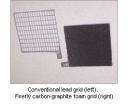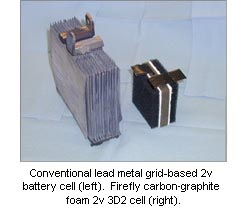Feb
6
The Next Big Improvement in Batteries Ships Soon
February 6, 2008 | 11 Comments
While all the world is watching the Lithium-Ion battery field with increasing interest the lead acid technology is closer than many would think to having similar power available at a much lower cost.
As weight equals both construction costs for materials and the mass for shipping and use in motive applications a quick review of the major chemistries is in order. One common chart holds that the regular lead acid battery (PbA) would weigh 138 pounds per kWh. Lith-ion ranges from 24 to 40 lbs per kWh. NiHH is at 40 lbs. The new Firefly ranges from 49 to 61 lbs.
There is a load of weight in using the current PbA that the Lith-ion can cut by 2/3s. If its not going to be moved, it only matters to the installation and replacements costs assuming the discharge cycles and depths are comparable. I often find hybrid cars offering that they’ll be carrying something like 15 to 20 kWhs of charge. That makes the lowest rated Firefly compared to the lowest rated Lith-ion carrying an extra 25 lbs per kWh, which could come to 500 lbs in a 20kWh set, whereas a conventional PbA set adds 2,200 lbs.
While this might seem heavy, in the end we’re likely to be checking the upfront cost and the operating expense. Here the Firefly shows its lead. The chart used for source is quoting a cost per mile for the best Lith-ion at $0.042 per mile and the Firefly at $0.013. Now carrying 500 pounds doesn’t seem so outlandish when it would save $2,900 in 100K miles.
That makes the contest clearly a weight vs. cost issue with the Firefly having a 4 to 1 advantage in cost per mile and in the upfront cost. We’d better be more informed.
Firefly Energy is a spinoff from the Caterpillar Research and Development Laboratory. The problem of battery performance for Caterpillar products was dropped on Kurt Kelly now the Chief Technology Officer at Firefly. Kelly adopted a set of issues to be solved to achieve a battery that could be sold with Caterpillar’s name plate. The issues were find a corrosion resistant material to replace the lead, choose and refine the material in such a way that the energy releasing chemistry could be harnessed in a more efficient manner.
The result is the carbon based composite foam integrated into the lead, which becomes a grid to hold the carbon foam in a plate like shape. The side benefit was the carbon foam lasts through many more cycles. Another benefit is that the foam being a collection of bubbles offers an enormous gain in exposed surface area for reactions. This reforming of the chemical interface architecture essentially doubles the usable value in the electrolyte and the anode and cathode plates.
The next issue that lead acid technology faces is the result of cycles “corroding” the lead plates which is a matter of the lead surface becoming covered with lead sulfate, the result of cycling and the reason lead acid batteries fail. The fine layer of lead sulfate just chokes off the reactions, making the fine cell and increased surface areas items that dramatically improve the cycle count and the depth of cycles before the lead sulfate can form enough to end the battery’s life.
Another problem that the Firefly helps to mitigate is the temperature issue. Batteries have optimal operating temperatures; due to the effect that temperature has on the rate at which the reactions can occur. The micro sized cells in the carbon foam limit the distances that electrolyte can travel so reducing the activity needed for supplying the electrolyte and the plates. This aspect neatly improves the temperature performance range.
The main benefit to the competing technologies of Lith-ion and NiMH is the total cycles and the depth of discharge available. Here the Firefly is claimed to be equivalent to the competition in cycles and discharge depth. The small cells in the carbon foam, the transfer distances and the temperature mitigation bring lead acid technology much closer to the recent chemistry competitors.
With Firefly working on the manufacturing of cell plates to sell to battery manufacturers and a shipping schedule announced for spring of 2008 some changes are in store for many battery users and new customers. Here at newenergyandfuel.com a concern is building about the level of available storage for the range of energy storage that is becoming necessary. The first product sales of the Firefly cells looks to be a big improvement as lead based storage will by necessity of cost, easy, quick and efficient adoption. When it comes to immediately available resources to store power, in an existing manufacturing base at costs that won’t stun or delay other innovations – Firefly Energy is an important resource.
Comments
11 Comments so far




Very interesting. Firefly looks like a good way to bridge from where we are now to where we will be in 10 or 20 years.
BTW, you may have left out a zero in your comparison of the Firefly cost (0.013/mi) vs the Li-ion (0.042/mi).
Thanks Al, the zero is where it belongs now. I’m looking for the combination of the Firefly to a supercapacitor next. This has got to be exciting.
[…] For the heavier, larger and lower invested cost market Lead-Acid with the new technologies such as Caterpillar’s Firefly will give good economical service with low cost recycling […]
Lead Acid batteries should be replaced with a new type of battery that weigh less :;’
I REALLY liked your post and blog! It took me a minute bit to find your site…but I bookmarked it. Would you mind if I posted a link back to your post?
I was just having a conversation over this I am glad I came across this it cleared some of the questions I had.
Of course, what a great site and informative posts, I will add backlink – bookmark this site? Regards, Reader
This post makes a lot of sense !
I’ve been checking your blog for a while now, seems like everyday I learn something new 🙂 Thanks
I am pleased I came across your blog on ask. Thanks for the sensible critique. My wife and i had been just preparing to do some research about it. I will be thrilled to see this kind of excellent information getting shared freely out there.
Exceptional web site. Lots of handy data right here. Therefore i’m delivering it to a couple of friends ans also revealing in delicious. Not to mention, thanks for your sweat!